South Bend, Indiana: Difference between revisions
m →Television: fixed date |
m →History: source |
||
| Line 74: | Line 74: | ||
During World War II, the [[South Bend Blue Sox]] [[All-American Girls Professional Baseball League]] team was formed in South Bend. The team participated in all the league's seasons from 1943-1954.<ref name="bluesox">All-American Girls Professional Baseball League "[http://www.aagpbl.org/league/history.cfm All-American Girls Professional Baseball League History]." Retrieved on [[2006-08-30]].</ref> |
During World War II, the [[South Bend Blue Sox]] [[All-American Girls Professional Baseball League]] team was formed in South Bend. The team participated in all the league's seasons from 1943-1954.<ref name="bluesox">All-American Girls Professional Baseball League "[http://www.aagpbl.org/league/history.cfm All-American Girls Professional Baseball League History]." Retrieved on [[2006-08-30]].</ref> |
||
By 1950, More than half of all employment was in the manufacturing sector.<ref name="EconMan">Indiana Business Review"[http://www.ibrc.indiana.edu/IBR/2002/outlook03/southbend.html ASouth Bend/Mishawaka - Elkhart/Goshen]." Retrieved on [[2008-01-02]].</ref> Due to economic difficulties, the [[Studebaker]] Company closed its automotive manufacturing plants in South Bend in December of 1963.<ref name="EarlyHist">Northern Indiana Center for History "[http://www.centerforhistory.org/indiana_stjoe_history.html#sb Early South Bend]." Accessed on [[2006-08-30]].</ref> A general decline in manufacturing soon followed. By the year 2000 manufacturing only made up 16% of the local economy, and the population decreased by nearly 30,000. |
By 1950, More than half of all employment was in the manufacturing sector.<ref name="EconMan">Indiana Business Review"[http://www.ibrc.indiana.edu/IBR/2002/outlook03/southbend.html ASouth Bend/Mishawaka - Elkhart/Goshen]." Retrieved on [[2008-01-02]].</ref> Due to economic difficulties, the [[Studebaker]] Company closed its automotive manufacturing plants in South Bend in December of 1963.<ref name="EarlyHist">Northern Indiana Center for History "[http://www.centerforhistory.org/indiana_stjoe_history.html#sb Early South Bend]." Accessed on [[2006-08-30]].</ref> A general decline in manufacturing soon followed. By the year 2000 manufacturing only made up 16% of the local economy, and the population decreased by nearly 30,000.<ref name="EconMan"> |
||
In 1984 South Bend community leaders began seeking a minor league baseball team for the city. A stadium was constructed in 1986 and a 10 year player development contract was signed with the [[Chicago White Sox]]. The team would be known as the South Bend White Sox. In 1994 the team's named was changed to the [[South Bend Silver Hawks]]. <ref name="Hawks">South Bend Silver Hawks "[http://www.silverhawks.com/coveleski/aboutcove/ About The Cove]." Accessed on [[2006-08-30]].</ref> |
In 1984 South Bend community leaders began seeking a minor league baseball team for the city. A stadium was constructed in 1986 and a 10 year player development contract was signed with the [[Chicago White Sox]]. The team would be known as the South Bend White Sox. In 1994 the team's named was changed to the [[South Bend Silver Hawks]]. <ref name="Hawks">South Bend Silver Hawks "[http://www.silverhawks.com/coveleski/aboutcove/ About The Cove]." Accessed on [[2006-08-30]].</ref> |
||
Revision as of 16:03, 6 January 2008
City of South Bend, Indiana | |
|---|---|
 South Bend from above | |
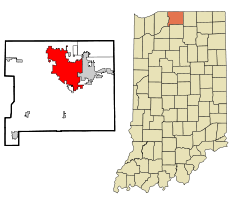 Location in the state of Indiana | |
| Country | United States |
| State | Indiana |
| County | St. Joseph |
| Incorporated (City) | 1865 |
| Government | |
| • Type | Strong Mayor-Council |
| • Mayor | Stephen Luecke (D) |
| Area | |
| • Total | 39.1 sq mi (101.3 km2) |
| • Land | 38.7 sq mi (100.2 km2) |
| • Water | 0.4 sq mi (1.1 km2) |
| Elevation | 692 ft (211 m) |
| Population (2000) | |
| • Total | 107,789 |
| • Density | 2,787/sq mi (1,075.9/km2) |
| Time zone | UTC-5 (EST) |
| • Summer (DST) | UTC-4 (EDT) |
| ZIP codes | 46600-46699 |
| Area code | 574 |
| FIPS code | 18-71000Template:GR |
| GNIS feature ID | 0452796Template:GR |
| Website | http://www.southbendin.gov |
South Bend is a city in St. Joseph County, Indiana, United States. As of the 2000 census, the city had a total of 107,789 residents; its metropolitan area had a population of 316,663. It is the fourth largest city in Indiana and county seat of St. Joseph CountyTemplate:GR. It is the economic and cultural hub of the region commonly known as Michiana, and is best known as the home of the University of Notre Dame.
South Bend lies along the Indiana Toll Road at the south most turn in the St. Joseph River, from which it derives its name. The area was originally settled in the early 19th century by fur traders, and established as a city in 1865. The St. Joseph River shaped South Bend's economy through the mid 20th century. River access led to heavy industrial development that peaked with Studebaker being based out of the city, along with Oliver Chilled Plow Company and several other industrial companies.
The population of South Bend has steadily declined since its peak at around 133,000 in the 1960s. This is in large part to the demise of Studebaker and other heavy industry. Today, the largest industries in South Bend are health care, education, and small businesses. A large tourism sector also exists, mainly supported by the University of Notre Dame. Despite the decrease in population, South Bend still remains the focal point for Michiana, with the second busiest airport in Indiana, interurban rail service to downtown Chicago, and several large businesses including Crowe Chizek and AM General.
History
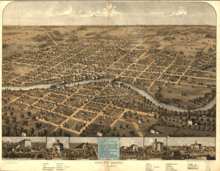
The first settlements in the current South Bend area were established as fur trading posts. The first westerner to make permanent settlement was Pierre Frieschutz Navarre in 1820. Navarre arrived on behalf of the American Fur Company. His home was not far from what would become downtown South Bend.[1] Alexis Coquillard, another agent of the American Fur Company, passed through South Bend in 1823 and returned in 1824 with his family to make it his home.[1][2] At the time, the post was known as Big St. Joseph Station. In 1827, Lathrop Minor Talyor established a post for Samuel Hanna and Company. The area soon became known as St. Joseph’s, Indiana as recorded in the Samuel Hanna and Company records.[2] By 1829, the town was growing, with Coquillard and Taylor emerging as leaders. The town applied for a post office, and Taylor was named postmaster later that year. The town was designated as Southold, Allen County, Indiana [1]. The following year, the name of the city was changed to South Bend. This change was in order to ease confusion as several other communities called Southold existed at the time. [3] In 1831 South Bend was laid out as the county seat and as one of the four original townships of St. Joseph County. Soon after, design began on what would become the town of South Bend[1]
The area was incorporated as a town in 1835 and rapidly grew. During the late 1830s through the 1850s, much of South Bend's development centered around the industrial complex of factories located on the two races (man-made canals along the St. Joseph River in South Bend). Several dams were created, and mills were built on each side of the river. On October 4, 1851, the first steam locomotive entered South Bend.[1]This led to a general shift of businesses from the river toward the tracks. In 1852, Henry Studebaker set up a wagon shop in South Bend. Studebaker would go on to become a large automobile manufacturer of the United States. Other manufacturing companies such as the Singer Sewing Company and the Oliver Chilled Plow Company would soon follow suit, and manufacturing would become the driving force in the South Bend economy through the mid 20th century.[1]
South Bend also gained from its position on what was known as The Michigan Road, the main north-south artery of northern Indiana in the 19th century.[1] Another significant development occurred near South Bend in 1842, when the Reverend Edward Sorin founded the University of Notre Dame, just north of the town.[4] Notre Dame would eventually become an intrinsic part of South Bend, contributing greatly to the economy and culture.[5] In 1865, a petition was introduced for South Bend to incorporate as a city. South Bend held its first elections as a city on Monday, June 5, 1865.[2]
Other industries continued to develop in South Bend in the early twentieth century, including Birdsell Manufacturing Company, the Bendix Corporation, Honeywell, AlliedSignal, the Robert Bosch GmbH, South Bend Lathe Works, the O'Brien Paint Corp., and the South Bend Toy Company. Fast development led to the creation of electric rail transportation throughout the area, and in 1925 and the South Shore interurban streetcar service was established from downtown South Bend to downtown Chicago. [6]
During World War II, the South Bend Blue Sox All-American Girls Professional Baseball League team was formed in South Bend. The team participated in all the league's seasons from 1943-1954.[7]
By 1950, More than half of all employment was in the manufacturing sector.[8] Due to economic difficulties, the Studebaker Company closed its automotive manufacturing plants in South Bend in December of 1963.[9] A general decline in manufacturing soon followed. By the year 2000 manufacturing only made up 16% of the local economy, and the population decreased by nearly 30,000.Cite error: A <ref> tag is missing the closing </ref> (see the help page).
Geography
According to the United States Census Bureau, the city has a total area of 39.1 square miles (101.3 km²), of which, 38.7 square miles (100.2 km²) of it is land and 0.4 square miles (1.1 km²) of it (1.10%) is water.
South Bend is located 5 miles (8 km) from the Michigan border, approximately equidistant from Illinois and Ohio. The city is 93 miles (150 km) driving distance from Chicago. The nearest shore of Lake Michigan is 20 miles (32 km) away. South Bend's coordinates are 41°40′21″N 86°15′19″W / 41.67250°N 86.25528°WInvalid arguments have been passed to the {{#coordinates:}} function (41.672597, -86.255157)Template:GR.
The St. Joseph River flows from the east end of the city turning north near the city center, giving South Bend its name at the bend in the river. South Bend sits on the North-South continental divide, and the river flows north into Lake Michigan.[10] The downtown area is located in the north central part of the city along the St. Joseph River, with Notre Dame directly adjacent to the north. The city extends further north on the west side, mainly with manufacturing and distribution facilities near the South Bend Regional Airport. Mishawaka is a adjacent to South Bend's east side.
Climate
South Bend has a humid continental climate, with a Köppen climate classification of Dfa. Lake Michigan has a large effect on the climate of South Bend, including lake effect snow in winter.[10]
| Month | Jan | Feb | Mar | Apr | May | Jun | Jul | Aug | Sep | Oct | Nov | Dec | Year |
|---|---|---|---|---|---|---|---|---|---|---|---|---|---|
| Avg high °F (°C) |
30 (-1) |
34 (1) |
45 (7) |
59 (15) |
70 (21) |
80 (27) |
83 (28) |
81 (27) |
74 (23) |
63 (17) |
48 (9) |
36 (2) |
50 (10) |
| Avg low °F (°C) |
17 (-8) |
19 (-7) |
28 (-2) |
38 (3) |
48 (9) |
58 (14) |
63 (17) |
61 (16) |
54 (12) |
43 (6) |
33 (1) |
22 (-6) |
40 (4) |
| Rainfall in. (mm) |
2.4 (61) |
2.0 (51) |
2.9 (74) |
3.7 (94) |
3.1 (79) |
4.0 (102) |
3.8 (97) |
3.7 (94) |
3.5 (89) |
3.3 (64) |
3.2 (82) |
3.0 (76) |
38.4 (965) |
- Source:Weatherbase.com [11]
Demographics
| Census | Pop. | Note | %± |
|---|---|---|---|
| 1870 | 7,206 | — | |
| 1880 | 13,280 | 84.3% | |
| 1890 | 21,819 | 64.3% | |
| 1900 | 35,999 | 65.0% | |
| 1910 | 53,684 | 49.1% | |
| 1920 | 70,983 | 32.2% | |
| 1930 | 104,193 | 46.8% | |
| 1940 | 101,268 | −2.8% | |
| 1950 | 115,911 | 14.5% | |
| 1960 | 132,445 | 14.3% | |
| 1970 | 125,850 | −5.0% | |
| 1980 | 109,727 | −12.8% | |
| 1990 | 105,511 | −3.8% | |
| 2000 | 107,789 | 2.2% |
As of the censusTemplate:GR of 2000, there were 107,789 people, 42,908 households, and 25,959 families residing in the city. The population density was 2,786.4 people per square mile (1,075.9/km²). There were 46,349 housing units at an average density of 1,198.1/sq mi (462.7/km²). The racial makeup of the city was 56.05% White, 34.60% African American, 0.41% Native American, 1.20% Asian, 0.06% Pacific Islander, 4.87% from other races, and 2.80% from two or more races. Hispanic or Latino of any race were 8.45% of the population.
Ancestries: Germans (17.4%), Polish (10.6%), Irish (10.5%), English (5.8%), United States (3.9%), Hungarian (3.3%) (from City-Data.com).
There were 42,908 households out of which 30.5% had children under the age of 18 living with them, 39.0% were married couples living together, 17.0% had a female householder with no husband present, and 39.5% were non-families. 32.5% of all households were made up of individuals and 12.7% had someone living alone who was 65 years of age or older. The average household size was 2.45 and the average family size was 3.12.
In the city the population was spread out with 27.3% under the age of 18, 10.4% from 18 to 24, 29.3% from 25 to 44, 18.2% from 45 to 64, and 14.8% who were 65 years of age or older. The median age was 33 years. For every 100 females there were 91.1 males. For every 100 females age 18 and over, there were 86.7 males.
The median income for a household in the city was $32,439, and the median income for a family was $39,046. Males had a median income of $31,958 versus $23,744 for females. The per capita income for the city was $17,121. About 13.6% of families and 16.7% of the population were below the poverty line, including 24.0% of those under age 18 and 9.1% of those age 65 or over.
Economy

South Bend's location on the St. Joseph River led to an industrial based economy in the late 1800s and early to mid 1900s. By the end of World War II that economy began to diminish.[12] Remnants of the old economy can still be seen in the abandoned industrial buildings around the city. Since that time education, health care, and small business have come to the forefront of South Bend's economy.
Nearby University of Notre Dame is a large contributor to the local economy. The university is the largest employer in St. Joseph County, employing 4,758 people.[5]
Health care is another major contributor to the South Bend economy. Memorial Health Systems is the largest employer in the city.[5] Other notable businesses include the AM General headquarters, Crowe Chizek, and Honeywell.
Efforts are underway to spur economic growth in South Bend. The St. Joe Valley Metronet is a not for profit organization attempting to create a more robust telecommunications infrastructure capable of inexpensive high speed data transmission. It is thought this could bring more high tech firms to the city and surrounding area.[13] Redevelopment is underway for some of the abandoned industrial facilities, with the abandoned Oliver Corp. buildings being the most recent example of reclaimed property.[14]
Arts and culture
Culture
South Bend was influenced by a large influx of Polish Catholic immigrants in the late 19 century.[15] Dyngus Day is widely celebrated the Monday after Easter, and as is known locally to be the beginning of the city elections campaign season.[16] Fat Tuesday is also celebrated in South Bend, with Paczkis being a staple food product in the city for the day.[17] There are twenty three Catholic churches in the city and surrounding county, eleven Catholic schools, and three Catholic universities just outside the city in Notre Dame, Indiana.[18]
The World Pulse Festival is held annually in South Bend. The festival is an annual Contemporary Christian music festival, attracting more than 50,000 visitors each year. [19]
Museums, arts and entertainment
The South Bend Regional Museum of Art is located in the Century Center in downtown South Bend. The Museum was opened to the public in March of 1996, and features a variety of artists from South Bend and the Michiana region. Currently, over 850 works are featured in the permanent collection. The museum also offers several classes and workshops for adults and children.
Copshaholm is one of the central features of the Northern Indiana Center for History. The 38 room mansion was built in 1895 and is currently listed in the National Register of Historic Places. The history museum is composed of several buildings on its campus. It includes areas dedicated to the history of the St. Joseph River Valley, the University of Notre Dame, the All-American Girls Professional Baseball League, and the Kidsfirst Children's Museum.[20]
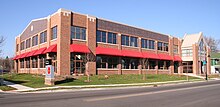
The Studebaker National Museum is a large collection of wagons and automobiles from the 150 year production history of the Studebaker company. The museum began as a collection of wagons and automobiles produced by Studebaker, including the Presidential carriages of Lincoln, McKinley, Harrison and Grant. The company donated the collection to the city of South Bend in 1966. The collection was housed in various locations from the Century Center to its current location in downtown South Bend adjacent to the Northern Indiana Center for History. The two museums share one campus, and together form The Museums at Washington and Chapin.
South Bend is also home to the Morris Performing Arts Center. The center was built in 1922 and included The Palace Theater which featured vaudeville acts. The theatre saw its heyday in 1940 with the premiere of Knute Rockne, All American which starred Ronald Reagan. A crowd estimated at 24,000 gathered outside the event. The theater was scheduled for demolition in 1959, when E.M. Morris purchased the facility and sold it to the city for one dollar. The Palace was then renamed the Morris Civic Auditorium. A total renovation was completed in 2000. The Morris Performing Arts Center also includes the Palais Royale Ballroom, on which restoration was recently completed. The center serves as home to the South Bend Symphony Orchestra, as well as the Broadway Theater League.
Schuyler Colfax, the 17th Vice President of the United States, is interred in the city cemetery.
Sports

The University of Notre Dame's Fighting Irish provide much of the sports action for the South Bend locale. Football Saturdays have become a major event for the city, attracting fans who want to see the games and tailgate. Notre Dame basketball games are also popular, along with the other sports at Notre Dame. Thanks in large part to the location of the University of Notre Dame in Notre Dame, Indiana to South Bend's immediate north, the College Football Hall of Fame was moved from Kings Mill, Ohio to downtown South Bend in 1995.
South Bend is home to the South Bend Silver Hawks, a class A Minor League Baseball team. The Silver Hawks play at Coveleski Stadium in downtown South Bend. In 2005 the franchise nearly moved to Marion, Illinois. A group of investors led by former Indiana Governor and South Bend Mayor Joe Kernan bought the Silver Hawks, keeping the team in South Bend.
The South Bend Motor Speedway was constructed from 1944-1946 on South Bend's west side. The speedway features a 1/4 mile track. Currently there are weekly races of Sportsman Late Models, Mini-stock cars and Thunder Cars, along with other events including concerts, car shows, and swap meets.
Parks and recreation
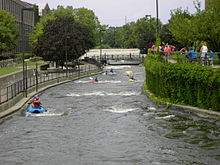
The Potawatomi Zoo opened in 1902. Potawatomi is the oldest zoo in Indiana, and features over 400 animals in its 23 acres. The zoo is run by the South Bend Parks and Recreation Department which maintains a variety of parks and facilities for the city.
Near the Potawatomi Zoo are the Potawaomi Greenhouses and Ella Morris and Muessel-Ellison Botanical Conservatories. The green houses were originally constructed in the 1920s, with the conservatories being added in the 1960s. [21]. In 2007 the greenhouses and conservatories were in danger of closing due to increased operating costs, but a campaign by the Botanical Society of South Bend was able to solicit funds to keep the facilities operating.
The city is home to the first of the few artificial white water courses in the United States. In 1984 the abandoned East Race canal of the St. Joseph River was converted into North America's first artificial whitewater waterway.[22] Through the use of movable barriers and obstacles the East Race provides a configurable whitewater course for recreational and competitive canoeing, kayaking and rafting.
Government

South Bend government follows the mayor-council representative municipal government model. The government operates out of the County-City building in downtown South Bend. The government of St. Joseph county also operates at this facility.
The government of South Bend is led by the office of the mayor. The mayor is elected to a four year term and acts as chief executive for the city government. [23]
The legislative branch of the South Bend government is the city council. The council is composed of nine members each elected to four year terms. South Bend is divided into six districts, each district electing one council member. The final three members are elected at-large. Under Indiana state law, the council may pass resolutions and ordinances. Resolutions are in regard to internal council procedures, while ordinances address city municipal codes.[24]
The final elected member of the South Bend government is the City Clerk. The city clerk is responsible for maintaining official city records, and providing general clerical assistance to the City Council. [25]
Education
Higher education

The South Bend area is home to several institutions of higher learning; the most famous of which is the University of Notre Dame. The university is located to the north of South Bend in Notre Dame, Indiana, possessing its own ZIP code (46556). The University of Notre Dame was founded by Father Edward Sorin, a French priest, in 1842 even before South Bend was incorporated as a city in 1865, and has been an intrinsic part of the South Bend area with great effect on its culture and economy. St. Mary's College and Holy Cross College are both located near Notre Dame just north of the South Bend.
Indiana University South Bend is the third largest campus in the Indiana University system. Enrollment in Fall 2007 was 7,517.[26] Other universities with campuses in South Bend include Brown Mackie College, Ivy Tech Community College of Indiana, Purdue University, Davenport University, and the Graduate Theological Foundation.
Primary and Secondary Centers
Public schools in South Bend are operated by the South Bend Community School Corporation. The corporation runs 17 primary centers (grades K-4), nine intermediate centers (grades 5-8), and four high schools, serving over 22,000 students as of 2006.[27]
The Diocese of Fort Wayne-South Bend operates eleven private Catholic schools in South Bend. [28] South Bend is also home to Indiana's First Charter School, Veritas Academy.
Media
Printed media
One major daily newspaper serves the South Bend Metro area, the South Bend Tribune. It is distributed throughout the Michiana region and publishes five editions including a Metro edition, Mishawaka edition, Michigan edition, Penn-Harris-Madison East edition and a Marshall edition.
Radio
South Bend has a wide variety of local radio broadcast available in the area. Stations' programming content contains a wide variety including public radio, classical music, religious, country, and urban contemporary among others. For more information, see List of Radio Stations in South Bend, Indiana.
Television
South Bend-Elkhart is the 89th largest television market in the United States as of 2007.[29] Most of the major television networks have affiliates in the South Bend area. WNDU-TV (NBC), WSBT-TV (CBS) and WSJV (FOX) all have local news teams. WBND-LP (ABC), WNIT-TV (PBS), WCWW-LP (CW), WMYS-LP (My Network TV) and WHME-TV (LeSEA), also broadcast across the greater Michiana region.
LeSEA Broadcasting is based in South Bend [30]
Infrastructure
Transportation
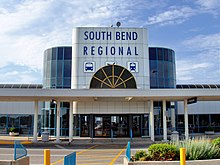
South Bend's location around the St. Joseph River has influenced the development of its streets. While it mainly follows a grid layout, development around the river led to roads adapted to follow the river. South Bend is connected to state and national highway systems by Indiana 2, 23, 933, US 20, 31 and by Interstate 80 & 90. Original routes of both the Lincoln Highway and the Dixie Highway also pass through South Bend. The Headquarters for the Lincoln Highway Association are in South Bend. [31]
For transportation around the South Bend metro area, the St. Joseph Valley Parkway was constructed between 1960 and 1990. The road connects Benton Harbor, Michigan, South Bend, Mishawaka, and Elkhart. While segments are designated as US 20, US 31 and Indiana 331, it is simply referred to locally as "The bypass".[32] The Indiana Toll Road passes through northern South Bend, labeled as I-80 and I-90.
Public transportation in South Bend is controlled by Transpo, (South Bend Public Transportation Company). Transpo operates bus routes between South Bend and suburbs Mishawaka and Roseland Monday through Saturday. Transpo routes cover 183 miles with over 60 vehicles.[33] In 2006, the Transpo fleet switched to Bio-diesel fuel.
South Bend serves as the transportation hub for Michiana. The South Bend Regional Airport lies off of US 31 and the Indiana Toll Road in the Northwest corner of South Bend. The airport connects South Bend to larger hubs including Atlanta, Chicago O'Hare, Cincinnati, Cleveland, Detroit, Indianapolis, Las Vegas, Minneapolis, Orlando, and St. Petersburg, Florida. Over 1,000,000 passengers are served annually making it the second busiest airport in Indiana. As of 2006, land acquisition is underway for 200 acres of development.[34]
The electric commuter railroad South Shore Line connects South Bend's South Bend Regional Airport to Millennium Station in downtown Chicago. Due to increased ridership between Chicago and South Bend in 2005 more cars are being added. In 2008 the South Shore will be celebrating its centennial anniversary. Planning for festivities are already underway and will take place at the South Bend Regional Airport.[35]
Amtrak, the national passenger rail system, provides service to South Bend via two trains, the Lake Shore Limited to Chicago, New York City and Boston and the Capitol Limited, to Chicago and Washington, D.C.. A bus line connects from Notre Dame and the airport to Chicago O'Hare Airport, with several northwest Indiana stops.[36]
See also
Sister Cities
 - Czestochowa (Poland)
- Czestochowa (Poland) - Arzberg (Germany)
- Arzberg (Germany)
References
- ^ a b c d e f g Palmer, John (2003). "At The Bend In The River". South Bend: Crossroads of Commerce. Arcadia Publishing. ISBN 0735852414X.
- ^ a b c Howard, Timothy E. (1907). "Chapter XI The City of South Bend". History of St. Joseph County, Indiana. The Lewis Publishing Company.
- ^ WSBT News South Bend Name Origin "WSBT News Why is South Bend Called South Bend?." Retrieved on 2007-03-17.
- ^ The University of Notre Dame Website "About Notre Dame." Retrieved on 2007-11-13.
- ^ a b c Bay Area Economics."Notre Dame and The Local Economy:2002." Retrieved on 2006-08-31.
- ^ Northern Indiana Commuter Transportation District "Our History." Retrieved on 2008-01-02.
- ^ All-American Girls Professional Baseball League "All-American Girls Professional Baseball League History." Retrieved on 2006-08-30.
- ^ Indiana Business Review"ASouth Bend/Mishawaka - Elkhart/Goshen." Retrieved on 2008-01-02.
- ^ Northern Indiana Center for History "Early South Bend." Accessed on 2006-08-30.
- ^ a b WSBT"What Does the 'North/South Continental Divide' Sign on the Bypass Mean?." Retreived on 2008-01-06 Cite error: The named reference "climate" was defined multiple times with different content (see the help page).
- ^ [1], Weatherbase.com (Accessed July 1, 2006)
- ^ Historic South Bend"South Bend's Historical Heritage." Retrieved on 2006-08-31.
- ^ St. Joe Valley Metronet"St. Joseph Valley Metronet Home." Retrieved on 2006-09-01.
- ^ City of South Bend website."South Bend Economic Development: Oliver Park." Retrieved on 2006-08-31.
- ^ Swastek,Joseph. "PolishRoots.". Retrieved on January 2, 2008.
- ^ WHAT YOU NEED TO KNOW ON DYNGUS DAY "DyngusDayBuffalo.com.". Retrieved on January 2, 2008.
- ^ South Bend Prepares for Mardi Gras "WNDU.". Retrieved on January 2, 2008.
- ^ Diocese of Fort Wayne - South Bend "Area Schools and Parishes.". Retrieved on January 2, 2008.
- ^ World Pulse Festival Attracts 50000+ "http://news.spirithit.com/index/culture_art/more/world_pulse_festival_attracts_50000/. Spirit News". Retrieved on January 2, 2008.
- ^ Center for History Exhibits"Center for History." Retrieved on 2006-08-30.
- ^ South Bend Parks and Recreation Conservatory Website "South Bend Conservatory." Retrieved on 2008-10-23.
- ^ South Bend Parks and Recreation "Center for History." Retrieved on 2006-08-30.
- ^ South Bend Municipal Government "South Bend Municipal Government." Retrieved on 2008-10-23.
- ^ South Bend City Council "South Bend City Council." Retrieved on 2008-10-23.
- ^ City of South Bend - About the Clerk "City of South Bend - About the Clerk." Retrieved on 2008-10-23.
- ^ Indiana University South Bend "Enrollment Reports." Retrieved on 2007-12-31.
- ^ South Bend Community School Corporation Website. [South Bend Community School Corporation] Retrieved on 2007-12-31
- ^ The Diocese of Forty Wayne-South Bend Website. [Find a Catholic School] Retrieved on 2007-12-31
- ^ http://www.lostremote.com/2007/08/23/new-nielsen-dma-rankings-released/
- ^ Lesea Homepage"About Us". Retreived on 2008-01-06.
- ^ "Lincoln Highway Association Headquarters open in South Bend". Marc Fannin. Retrieved 2008-02-01.
- ^ "Routes in South Bend and Metro Northern Indiana". Retrieved 2007-02-10.
- ^ "Transpo General Information". Transpo. Retrieved 2007-02-10.
- ^ "South Bend Regional Airport". Airport Hotel Guide. Retrieved 2007-02-10.
- ^ "South Shore Line plans centennial gala". NWI Times. Retrieved 2007-02-10.
- ^ "Amtrak Stations - South Bend". Amtrak. Retrieved 2008-01-02.


